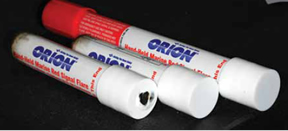
Photos by of Ralph Naranjo

Photos by of Ralph Naranjo
In a recent emergency procedures training course at the Annapolis School of Seamanship (www.annapolisschoolofseamanship.com) a handheld Orion flare melted through its handle and began dripping hot slag. Course coordinator Matt Benhoff said, “The trainee operating the flare was wearing heavy leather gloves and goggles and dropped the malfunctioning pyrotechnic flare in a disposal bucket before the problem led to an injury.” If a similar scenario played out in a life raft, hot slag could injure a sailor already in trouble, or result in raft damage if the molten slag landed on an inflated buoyancy tube.
Upon taking a close look at the melted base of the handheld flare, we noted that the hot slag had burned all the way to the plastic end cap and then melted its way through the cap itself. In the above photo it’s easy to recognize the difference between the intact base of a flare that has burned according to design and the one that malfunctioned. These were all new USCG approved flares, less than 25% into their usable life span.
In an emergency situation, pyrotechnic signals remain one of best ways to attract the attention. However, the user needs to recognize that they are quite literally holding fire in their hand and should be prepared to cope with a malfunction, especially in a life raft.
We contacted Orion (www.orionsignals.com) about the incident. According to the flare maker, “Orion has manufactured millions of handflares over the years, and this is the first time we have seen or heard of this issue.” The company plans to inspect the remains of the malfunctioning flare. We’ll keep you posted once Orion’s investigation concludes.





































